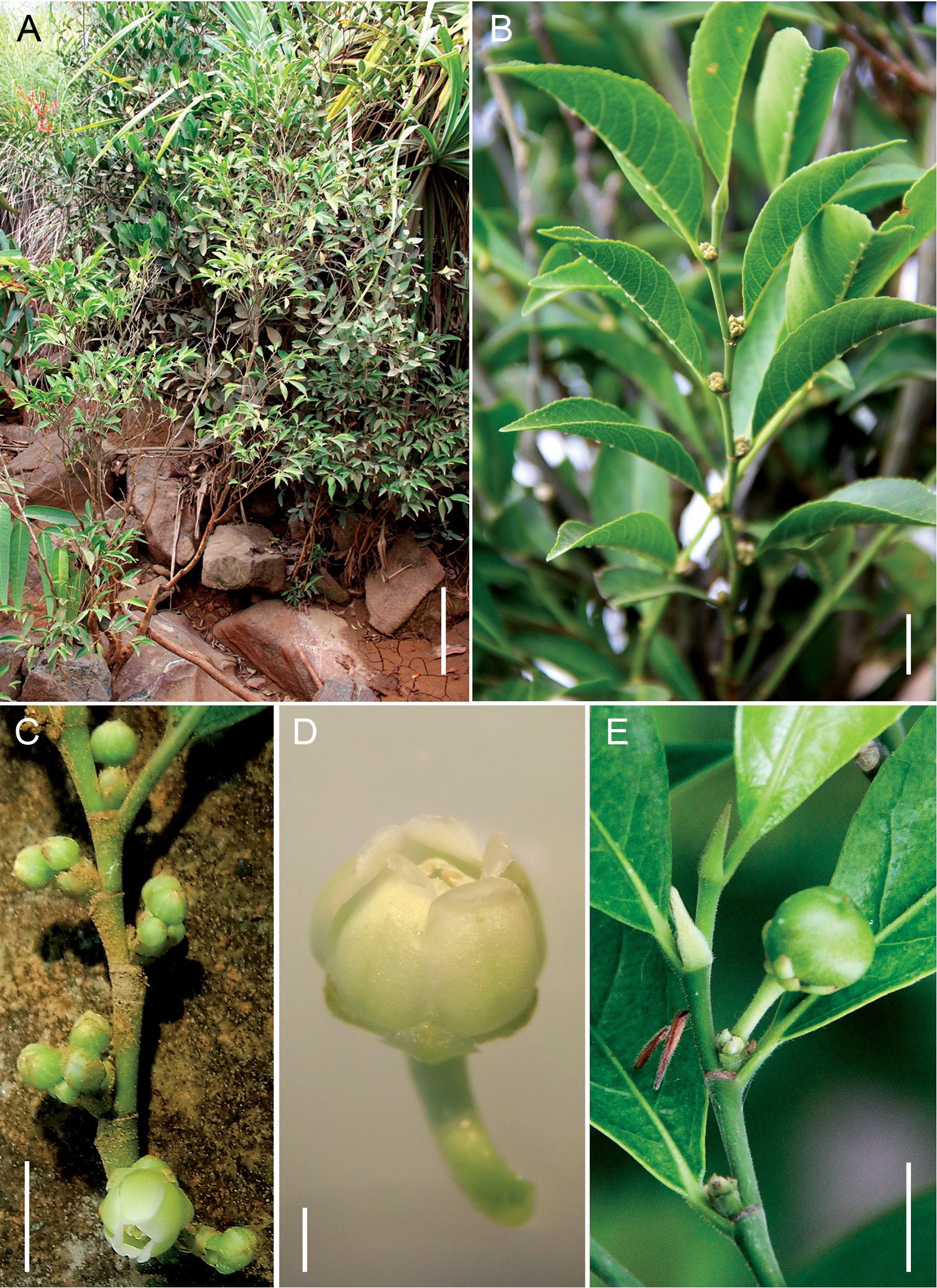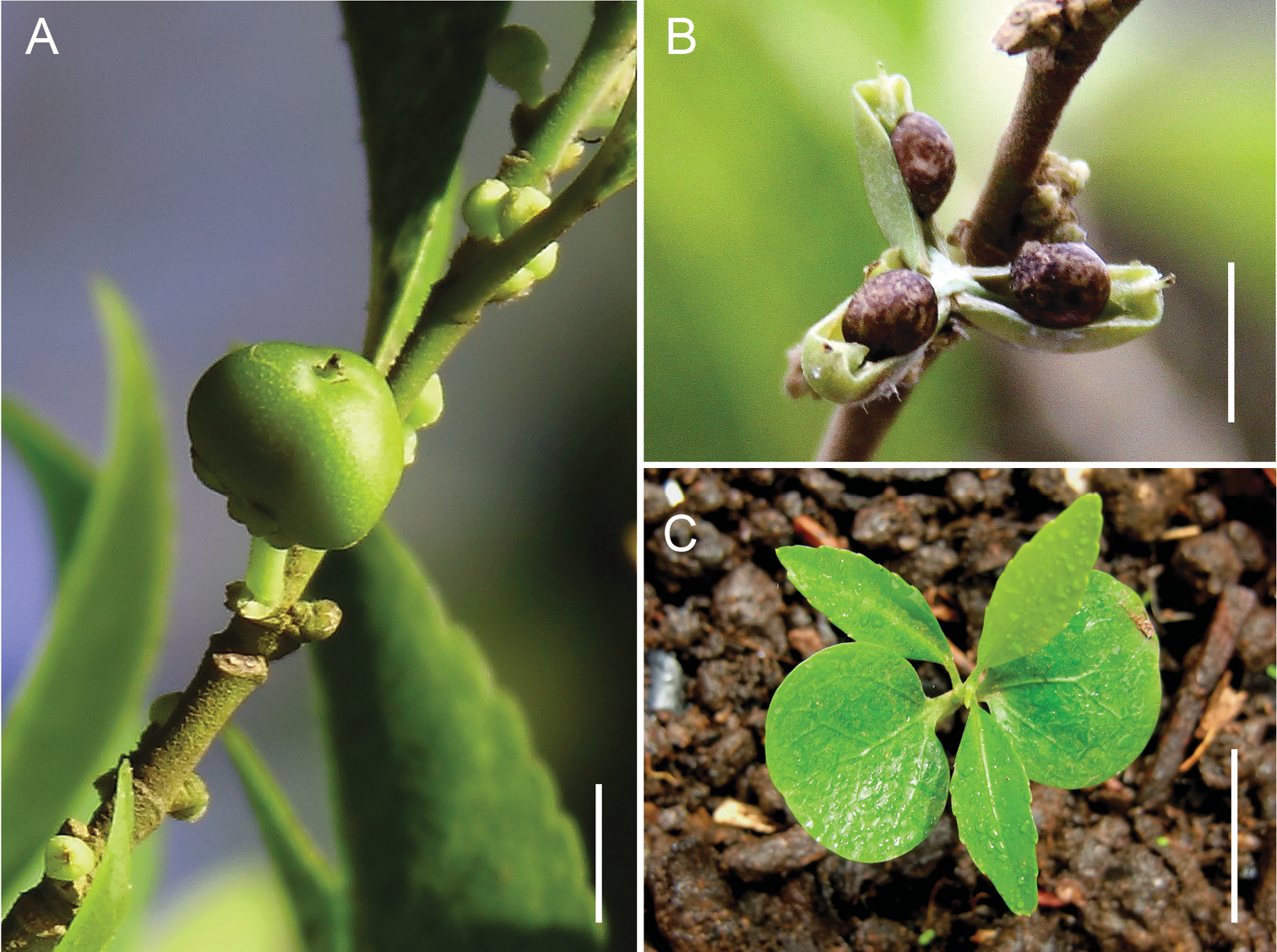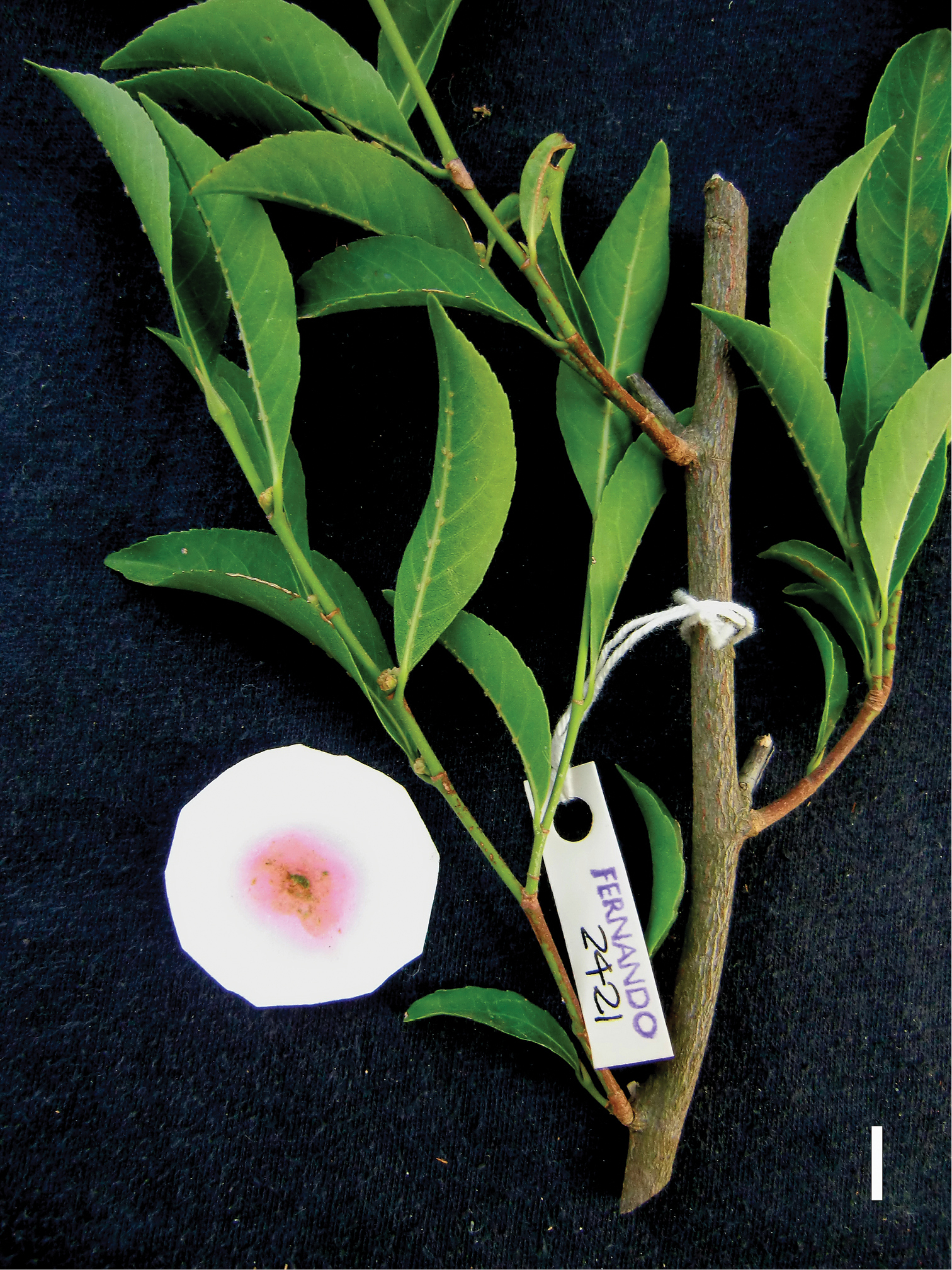






Citation: Fernando ES, Quimado MO, Doronila AI (2014) Rinorea niccolifera (Violaceae), a new, nickel-hyperaccumulating species from Luzon Island, Philippines. PhytoKeys 37: 1–13. doi: 10.3897/phytokeys.37.7136
A new, nickel-hyperaccumulating species of Rinorea (Violaceae), Rinorea niccolifera Fernando, from Luzon Island, Philippines, is described and illustrated. This species is most similar to the widespread Rinorea bengalensis by its fasciculate inflorescences and smooth subglobose fruits with 3 seeds, but it differs by its glabrous ovary with shorter style (5 mm long), the summit of the staminal tube sinuate to entire and the outer surface smooth, generally smaller leaves (3–8 cm long × 2–3 cm wide), and smaller fruits (0.6–0.8 cm diameter). Rinorea niccolifera accumulates to >18, 000 µg g-1 of nickel in its leaf tissues and is thus regarded as a Ni hyperaccumulator.
Hyperaccumulator, Rinorea, serpentine soils , ultramafics, Violaceae
Rinorea Aublet (Violaceae) is a pantropical genus of forest shrubs and trees. It is the second most species-rich genus in the family after Viola L., with an estimated total of 225–275 species throughout the tropics (
In Rinorea, at least three species are known to hyperaccumulate the heavy metal nickel. Rinorea bengalensis (Wall.) Kuntze was the first nickel hyperaccumulator species of Rinorea discovered with up to 17, 500 µg g-1 (dry weight) based on herbarium specimens from throughout Southeast Asia, including the Philippines (
The Violaceae also includes two other genera that hyperaccumulate nickel. In Agatea A.Gray, one species from New Caledonia, Agatea longipedicellata (Baker f.) Guillaumin & Thorne, has been recorded to accumulate up to 2, 500 µg g-1 of nickel in its foliar tissues (
The ability to absorb certain metals and metalloids (chemical elements with properties in between those of metals and non-metals, also referred to as semi-metals) from the soil and to accumulate them in shoot tissues in exceptionally high and normally toxic concentrations without any evidence of physiological stress is rather rare among plants (
Apart from their unusual and interesting ecology and physiology, hyperaccumulator plants have received considerable attention owing to the possibility of exploiting their accumulation traits for practical applications, especially in the development of so-called environmentally green technologies, e.g. phytoextraction, phytoremediation of heavy metal in contaminated soils, or phytomining to recover commercially valuable metals in plant shoots from mineralized sites (
In the Philippines, much of the forest flora on ultramafic or serpentine soils (
The morphology of the species presented here was based on field, vegetative, and reproductive characters. Field characters were recorded on site. Vegetative characters were observed and measured from press-dried specimens and seedlings and reproductive characters from fresh specimens and from material preserved in 70% ethanol. Detailed morphological measurements were made using digital calipers and a calibrated eye piece under a dissecting microscope. Herbarium specimens were also consulted and compared at CAHUP, LBC, PNH, and PUH, including additional material, e.g. images of type specimens of Southeast Asian and Philippine Rinorea available online at BISH, K, L, MO, NY, and US. All photographs, except where indicated, were taken in the field in the natural habitat of the species. Conservation threat assessment follows IUCN Categories and Criteria (
Field semi-quantitative screening for nickel accumulation in this species was performed on site on leaf samples, thoroughly washed in distilled water, crushed in a mortar and pestle, and tested on filter paper previously impregnated with 1% of the nickel-specific colorimetric reagent, dimethylglyoxime, dissolved in 95% ethanol (
urn:lsid:ipni.org:names:77138469-1
http://species-id.net/wiki/Rinorea_niccolifera
Figures 1, 2Rinorea niccolifera is most similar to Rinorea bengalensis by its fasciculate inflorescences and smooth subglobose fruits with 3 seeds, but it differs by its glabrous ovary with shorter style (5 mm long), the summit of the staminal tube sinuate to entire and the outer surface smooth, and its generally smaller leaves (3–8 cm long × 2–3 cm wide) and smaller fruits (0.6–0.8 cm diameter).
TYPE: PHILIPPINES. Luzon Island: Zambales Province, Municipality of Sta. Cruz, Lucapon, in remnant forest on ultramafic soils, along a gully with large boulders, 330 m elevation, flowers and immature fruits, 01 April 2012, Fernando 3016 (holotype LBC; isotypes CAHUP, K, PNH, SING).
Shrub or small tree, 1.5–8 m tall; stem 3–13 cm diameter, outer bark generally smooth, inner bark whitish; young twigs rather zigzag, with prominent stipular scars. Leaves simple, distichous, lamina elliptic to narrowly obovate, (2–) 3–8 (–10) cm long × (1–) 2–3 (–4) cm wide; the margins finely serrate, especially towards the distal half; base acute; apex acute to acuminate; secondary nerves (6–) 8–12 (–13) on each side of the midrib, diverging 40–60° from the midrib; hairy pit domatia very prominent along the midrib on abaxial surface; petiole terete, (–2) 3–5 (–7) mm long; young leaves white or greenish-white, growing in flushes. Stipules narrowly lanceolate, (4–) 6–7 (–8) mm long × 1 mm wide at the base, prominently covering the apical bud, caducous and leaving a distinct scar. Flowers white or cream, bisexual, globose or broadly ovoid, 3.1–3.3 mm long × 3.1–4 mm wide, in dense axillary clusters or fascicles of up to 3–5, sometimes more, rarely solitary; pedicel 2.5–3.2 mm long, 0.7–0.9 mm wide, sparsely covered with fine, short hairs. Sepals 5, free, subequal in size and shape, nearly as wide as long, broadly ovate, 1.3–1.6 × 1.3–1.6 mm, shorter than the petals, light green or greenish-white, distinctly 2–4 (–5) veined, margins entire, ciliate towards the distal half and sometimes covered with brown fine hairy indumentum at the apex. Petals 5, free, subequal in size and shape, broadly oblong to ovate, the apex rounded or obtuse, 2.2–2.7 mm long × 1.3–1.7 mm wide, white or greenish-white, paler towards the apex, the tip slightly deflexed or recurved, margins smooth or sometimes slightly ciliolate near the apex. Stamens 5; anther with 2 thecae, 1 mm long × 0.6 mm wide; connective appendage broadly ovate, 0.4 mm long × 0.7 mm wide, membranous, cream or light orange, the margins fimbriate; filaments as long as the tube, 0.6 mm long × 0.2 mm wide, inserted on the inner surface of the staminal tube surrounding the ovary; staminal tube shallowly 5-lobed, 0.6 mm tall and 0.7 mm thick, the summit sinuate to entire, outer and inner surfaces glabrous, smooth. Ovary ovoid, glabrous, smooth, 1 mm long, 0.9–1 mm diameter, with 3 locules; ovule 1 each per locule; style 0.5 mm long × 0.3 mm wide, erect; stigma pointed, undifferentiated. Fruit a capsule, globose or depressed globose, obscurely 3-angular, 6.5–7 mm long × 6–8 mm wide, green, turning pale green when ripe, glabrous, subtended by the persistent sepals and petals; remnant of stigma prominent, 1–1.5 mm long; 3-locular, dehiscent along three sutures, the locules 7–8 mm long, 5 mm wide and 4 mm deep, folding inwards when seeds are released; pedicel 4–5 mm long, 1–1.5 mm thick. Seeds 3, one in each locule, globose, 3–4 mm long × 3 mm wide, mottled light brown; hilum distinct, white. Seedling with epigeal germination, phanerocotylar; cotyledons foliaceous, 8 mm long × 10 mm wide, apex slightly emarginate, base truncate or obtuse; eophylls simple, elliptic, spirally arranged, 11 mm × 5 mm, margins serrate.
Rinorea niccolifera Fernando. A Growth habit at type locality B Twig with flower buds and leaves showing distinct domatia on abaxial surface C Twig with flowers in axillary sessile clusters or fascicles, some on young, leafless portions of the twig; note prominent stipular scars D Close-up of flower, showing recurved tips of petals E Twig with young fruit subtended by the persistent sepals and petals; note the caducous stipules. Scale bars: A = 20 cm; B, E = 10 mm; C = 5 mm; D = 1 mm A–E from Fernando 3016 (LBC). All photographs by Edwino S. Fernando.
Rinorea niccolifera Fernando. A Immature fruit showing depressed globose or obscurely 3-angular shape with prominent stylar remains B Mature, dehisced fruit showing three locules and seeds C Seedling showing foliaceus cotyledons and first three eophylls. Scale bars: A, B = 5 mm; C = 10 mm. A from Fernando 3016 (LBC), B from Fernando 3042 (LBC), C from Fernando 3042A (LBC), from seed of Fernando 3042 germinated in nursery. All photographs by Edwino S. Fernando.
Endemic in the Philippines. Luzon Island, Zambales Province, Municipalities of Sta. Cruz and Candelaria.
This species grows in forests on ultramafic soils, usually along gullies or sloping areas with large boulders or rocks at elevations of 320–825 m. In its type locality, Rinorea niccolifera was observed growing with Syzygium longissimum (Merr.) Merr. (Myrtaceae), Clerodendrum klemmei Elmer (Lamiaceae), Ixora ebracteolata Merr. (Rubiaceae), Severinia disticha (Blanco) Swingle (Rutaceae), Diospyros ferrea (Willd.) Bakh. (Ebenaceae), Calophyllum pentapetalum (Blanco) Merr. (Calophyllaceae), Dillenia luzoniensis (Vidal) Merr. (Dilleniaceae) and Terminalia pellucida C.Presl (Combretaceae), among several other woody plant species. In some other sites within its range in the ultramafic area of Sta. Cruz and Candelaria in northern Zambales, Rinorea niccolifera may occur together with Rinorea bengalensis, the latter also a nickel hyperaccumulator, but is generally a larger tree reaching to 15 m tall and with stem diameter of up to 25 cm (see also further in Key to the species).
Philippines, Luzon Island, Zambales Province, Municipality of Sta. Cruz, Lucapon, along a gully with large boulders, 320 m elevation, flower buds, 19 April 2011, Fernando 2421 (K, LBC, PNH), Fernando 2422 (LBC, PNH); flower buds, 01 April 2012, Fernando 3015 (CAHUP, LBC, PNH), mature fruits and seeds, 26 May 2012, Fernando 3042 (LBC, PNH); Municipality of Candelaria, Malimlim area, on steep slope with rocky soil, 630 m elevation, sterile material, 18 January 2013, Fernando 3072 (LBC), juvenile flower buds, 18 January 2013, Fernando 3073 (LBC, PNH), 605 m elevation, sterile material, 18 May 2013, Fernando 3161 (CAHUP, LBC), on steep slope, 750 m elevation, sterile material, 18 May 2013, Fernando 3181 (LBC), on ridge summit, 825 m elevation, sterile material, 19 November 2013, Fernando 3338 (LBC, PNH); Cultivated: Laguna Province, Los Baños, seedlings grown from seeds of Fernando 3042 germinated in nursery, 21 August 2012, Fernando 3042A (LBC).
The specific epithet niccolifera refers to the ability of this species to hyperaccumulate the heavy metal nickel in its stem and leaf tissues (from niccolum – Neo Latin for nickel, and; fer – to yield, to contain).
Following the IUCN Categories and Criteria (
| 1 | Ovules 6; lateral nerves often 16 or more on either side of the midrib | Rinorea horneri |
| – | Ovules 3; lateral nerves often less than 16 on either side of the midrib | 2 |
| 2 | Inflorescences more or less elongate, 0.5–2.6 cm long | Rinorea javanica |
| – | Inflorescences fasciculate, or flowers densely set on short rachis <0.5 cm long | 3 |
| 3 | Fruit ovoid, sparsely hairy; leaves without domatia on abaxial surface | Rinorea macrophylla |
| – | Fruit subglobose, smooth; leaves with domatia on abaxial surface | 4 |
| 4 | Ovary hairy; style 1 mm long; outer surface of staminal tube puncticulate, the summit irregularly lobed; fruit broader, 1–1.5 cm diameter; leaves generally larger, (6–) 9–16 (–22) cm long × (3–) 4–9 (–10) cm wide; stipules 9–13 (–14) mm long | Rinorea bengalensis |
| – | Ovary glabrous; style 0.5 mm long; outer surface of staminal tube smooth, the summit slightly sinuate to entire; fruit narrower, 0.6–0.8 mm diameter; leaves generally smaller, (2–) 3–8 (–10) cm long × (1–) 2–3 (–4) cm wide; stipules often less than 8 mm long | Rinorea niccolifera |
Field screening for Ni accumulation in Rinorea niccolifera using the colorimetric reagent, dimethylglyoxime (
Rinorea niccolifera Fernando, shown as a nickel hyperaccumulator by a field test using filter paper impregnated with 1% dimethylglyoxime dissolved in 95% ethanol. Scale bar = 10 mm. Fernando 2421 (LBC). Photograph by Edwino S. Fernando.
Mean and range values (in brackets) of Ni, Cu, and Co concentrations in leaves, stems, roots and rhizospheric soil of Rinorea niccolifera at two sites in Zambales Province, Luzon Island, Philippines. All concentrations are in µg g-1 dry matter. Mean values shown with standard errors.
| Site | Nickel (Ni) | Copper (Cu) | Cobalt (Co) |
|---|---|---|---|
| Sta. Cruz | |||
| Leaves |
13334.17 ± 1872.63 | 6.99 ± 0.14 | 37.66 ± 4.28 |
| (7168.27 – 17986.43) | (<5.00 – 7.37) | (27.56 – 51.46) | |
| Stems | 1880.51 ± 765.49 | 9.53 |
5.0 ± 1.21 |
| (779.34 – 4147.55) | (<5.00 – 9.53) | (<2.50 – 6.21) | |
| Roots | 1036.93 ± 163.22 | 7.19 ± 1.42 | 4.26 |
| (592.72 – 1331.18) | (<5.00 – 8.62) | (<2.50 – 4.26) | |
| Soil |
3981.54 ± 747.89 | 78.66 ± 11.64 | 579.75 ± 19.51 |
| (1869.54 – 5042.54) | (45.18 – 94.5) | (546.27 – 611.24) | |
| Candelaria | |||
| Leaves |
17497.69 ± 890.67 | <5.00 | 23.69 ± 2.34 |
| (16607.01 – 18388.36) | <5.00 | (21.35 – 26.03) | |
| Stems | 4742.94 ± 1964.77 | 7.44 ± 0.55 | 3.73 ± 0.06 |
| (2778.16 – 6707.71) | (6.89 – 8.00) | (3.66 – 3.79) | |
| Roots | 3060.93 ± 307.11 | <5.00 | 3.27 ± 0.13 |
| (2753.82 – 3368.04) | <5.00 | (3.14 – 3.40) | |
| Soil |
2756.04 ± 1021.89 | 241.36 |
363.36 ± 56.41 |
| (1734.15 – 3777.94) | (<5.00 – 241.36) | (306.96 – 419.77) | |
1 Voucher specimens for materials used for chemical analyses are as follows: Sta Cruz, 4 samples – Fernando 2421, 2422, 3015, 3016; Candelaria, 2 samples – Fernando 3073, 3161.
2 Total metal concentration in rhizospheric soil.
3 Based on single specimen record; others in the sample were below the set detection levels of 5.00 µg g-1 for Cu and 2.50 µg g-1 for Co.
This study is part of the Program on the Rehabilitation and Restoration of Mining Areas through Phytotechnologies which is funded by the Department of Science and Technology – Philippine Council for Industry, Energy, and Emerging Technology Research and Development (DOST-PCIEERD). Permission to collect plant specimens for scientific research was covered by Gratuitous Permit Nos. 199 and 211 issued by the Department of Environment and Natural Resources – Protected Areas and Wildlife Bureau (DENR-PAWB) of the Philippines. The Zambales Diversified Metals Corporation is gratefully acknowledged for allowing access to their mining concession and for help with providing on-site transport logistics. We thank the anonymous reviewers for their helpful comments on an earlier version of this manuscript.


